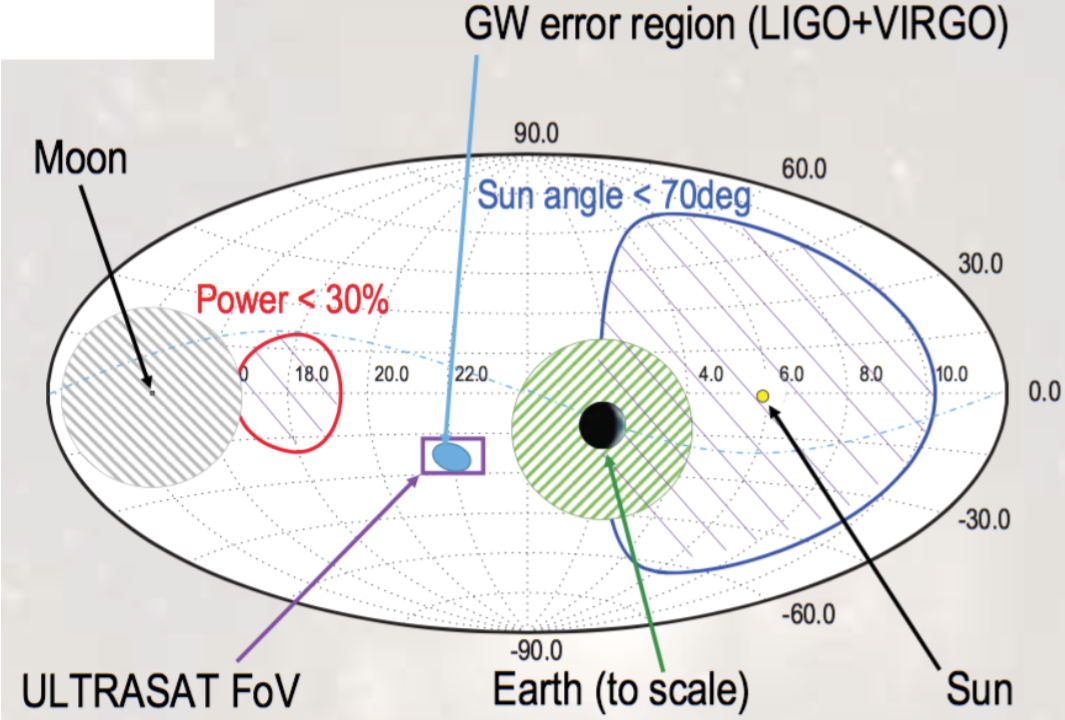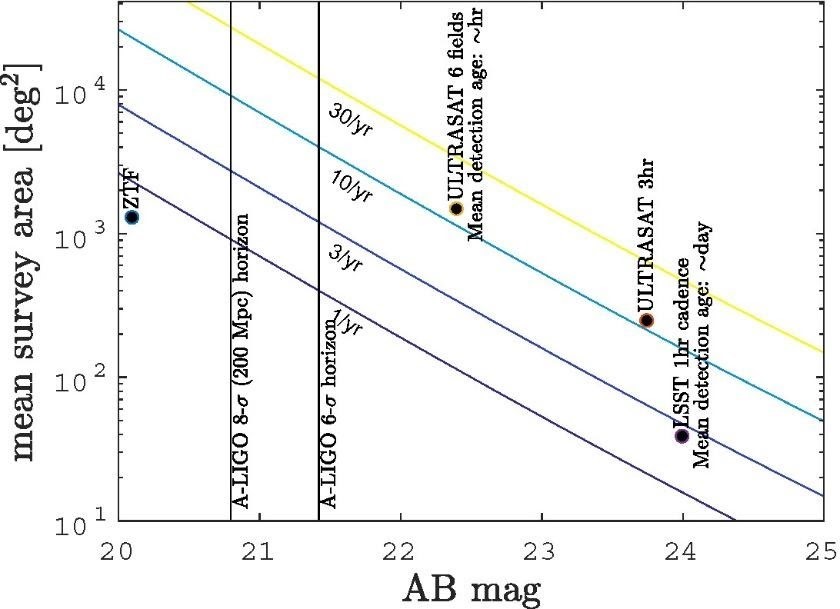The area of gravitational waves (GW) astrophysics has begun with the detection of GW from black-hole (BH) and Neutron Star (NS) mergers by the laser interferometer observatories LIGO and Virgo. The possibilities are many and exciting: new tests of general relativity, a new probe of stellar death in binary evolution, and determination of the demographics of stellar remnants. Coalescences involving NS provide unique insights into the physics of our Universe: They are the most likely sites of production of r-process elements (e.g., Pt, Au) and provide unique diagnostics of the physics of the densest matter in the Universe.
By 2025, GW interferometer networks are expected to provide a few to a few tens of detections of mergers involving NS per year within 200 Mpc (or 5 times more with the 350Mpc horizon of LIGO A+ and LIGOIndia), with angular localization of about 10-100 deg2 (long axes of 40-250) (Abbott et al. 2016 LRR 19, 1; 2018 LRR 21, 3). In this era, issue of GW alerts with rough parameter estimates (NS-NS, NS-BH or BH-BH; rough sky position & distance) are expected within minutes, and refined parameters within hours.
The detection of the associated electro-magnetic (EM) emission will be the key to using these events for addressing fundamental physics and astrophysics questions: It will provide direct constraints on the structure of the ejected material, which will in turn provide unique diagnostics of the properties of matter at nuclear density and of the merger dynamics; It will enable us to determine whether and which r-process elements are produced and whether highly relativistic gamma-ray burst (GRB) jets are produced; It will allow us to precisely localize the mergers. Determining the location in, and properties of, the host galaxy will reveal the stellar antecedents of NS mergers, and the host redshift distribution can be used to measure cosmological parameters, in particular H0.
NS-NS and NS-BH merger events (hereafter “GW events”) involve a density range of 1038, the entire periodic table, and sub-relativistic to relativistic flows. Modeling the EM output is thus a challenging but vibrant field. Many models predict a prompt UV signal, which may arise from 1) free neutron beta decay in high-velocity matter, 2) initial hot, low-opacity flare from an r-process rich (low Ye) ejecta before ion recombination drives later flux into the IR, 3) a blue/UV flare from neutrino-illuminated (high Ye) ejecta, 4) boosted relativistic material and/or shock cooling. Preliminary studies predict (e.g. Fernandez & Metzger 2016, ARNPS 66, 23) a UV flare lasting a few hours, emitting 1041-1042erg/s. Within the expected 200-350 Mpc horizon of GW detectors, the predicted UV signal is well-matched to the ULTRASAT sensitivity and exposure time, reaching 23 AB mag in 2 hr integration.
The detection of EM emission following the nearby (40 Mpc) NS merger event GW 170817 lends strong support to the estimates of the expected UV signal, and highlights the advantages of ULTRASAT as an EM counterpart detection machine. The EM counterpart of GW 170817 was detected 10 hours following the merger, with a luminosity of 1042erg/s and a temperature exceeding 10,000 K. This would be detectable by ULTRASAT out to 600 Mpc (or further, if, as likely, the emission is hotter at earlier time). The strength of ULTRASAT as a GW localization mission comes from its large FoV and rapid slew accessibility to >50% of the sky. Major ground-based optical/IR (OIR) facilities will also react to GW events. These facilities have the sensitivity to detect later optical emission if line-blanketing is not high, but have much lower real-time sky accessibility (~6% per location, given day/night, horizon, moon, and weather effects).

The ground-based detection of EM emission 10 hours following GW 170817, by targeting known galaxies in the GW source error volume, is an impressive result. However, earlier detection would be crucial for obtaining spectra and early light curves, which are essential for determining the properties of the ejecta (see more below). Furthermore, although the GW angular localization is expected to improve to 10-100 deg2 by 2025, EM transient identification will remain challenging as the GW detection horizon is increased to ~200 Mpc, implying a larger error volume containing hundreds to thousands of galaxies and fainter signals with a larger number of background transients that would need to be classified.
Before the ULTRASAT launch, several more GW events with exceptional properties (dense ISM, a rare on-axis orientation) might have been localized to their host galaxies. If so, the EM/GW frontier will be in early localization and in constructing larger, unbiased samples and detailed study of NS mergers, for which ULTRASAT is ideally suited.
What about EM searches in other bands? It is generally accepted that GW events involving NS can produce short hard gamma-ray bursts. So X-ray and γ-ray searches are clearly useful. However, there is sound empirical evidence that the prompt high energy emission is strongly “beamed” (conical emission). Only ~1 in 100 events will be aimed towards us and detectable at high energies. This is well supported by the very weak X/γ-ray counterpart of GW 170817, that would not have been detectable beyond 60 Mpc. The explosive energy of the coalescence will also drive a strong shock in the ambient medium, from which radio emission is expected to be detectable after months to years. The radio channel is attractive because it is isotropic. However, the long delay precludes key observational diagnostics for r-process elements – specifically OIR spectroscopy on timescales of days to a week. This conclusion is also well supported by the radio emission from GW 170817, that was detected with a two-week time delay despite its proximity.
With ULTRASAT’s rapid real-time response to a large sample (tens of ToO triggers per year) we aim to reach the following objectives:
01
Issue early position localizations to enable constraints on nucleosynthesis in disrupted NS matter
Given its speed of response, each ULTRASAT detection of a UV flare can provide an alert with a few arcseconds position within less than one hour of a GW event. This would enable follow-up, particularly optical/IR spectroscopy at peak, e.g. by JWST, VLT, Keck and ELT. By contrast, if the counterpart is only discovered in the OIR or radio, it might be impossible to obtain an optical spectrum at all, as the peak may shift beyond a micron in just one day. Spectroscopy is attractive because it provides a way to fully understand the astro-chemistry and address the long-standing question of whether (or not) neutron star mergers are the sites of r-process nucleosynthesis.

02
Provide UV light curves for a statistical sample of GW sources to measure ejecta properties
Since ULTRASAT can access half the sky at any time and cover the entire GW error ellipse in one point, it will build the most complete and unbiased sample possible of UV detections and non-detections of NS mergers. The full sample will constrain the geometric distribution, quantity, and kinematics of the hot, low, or intermediate opacity ejecta in such mergers. The importance of early UV light curves is well illustrated by the case of GW 170817 - different ejecta models have been proposed to explain the observed emission (in particular the early blue component), and early UV light-curves would be key to distinguishing between such models (e.g. Arcavi 2018 ApJ 855, L23).
03
Localize NS-NS and NS-BH mergers to their host galaxies
Determining the location in, and properties of the host galaxy will reveal the stellar antecedents of neutron star mergers. The host redshift distribution of these standard sirens can be used to measure cosmological parameters.
04
Detect un-triggered GW events. If the UV luminosity of GW 170817 is characteristic of GW events
ULTRASAT will be able to detect GW events blindly, well beyond the GW detectors’ horizon and without a GW detector trigger, at a rate similar to that of the detection of mergers by the GW signal (see Figure 2). This will provide information on the evolution of merging systems with cosmic time.

